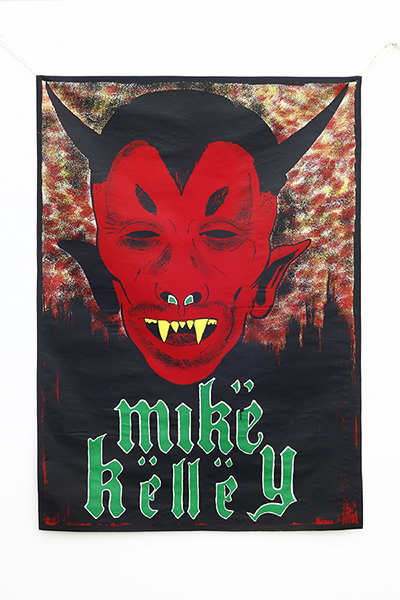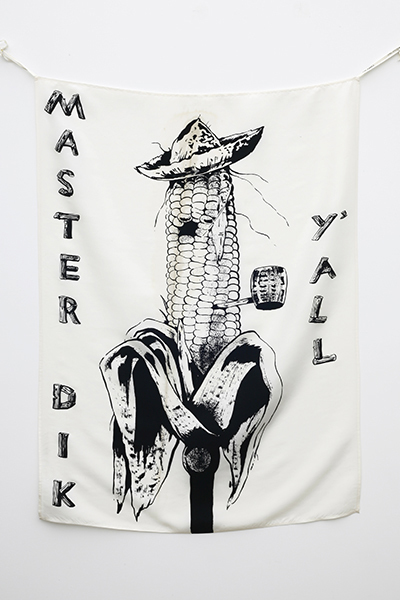The 1989 Los Angeles art scene represents a crucial period in contemporary art. Today creatives still turn to this incubator of post-punk for inspiration and intimidation. Central to this world was the late Mike Kelley, who worked alongside other icons like Paul McCarthy and Raymond Pettibon to challenge how we digested material from mass culture through art.
While somewhat under-represented in Australia, Kelley’s practice explores sexuality, class, modernism and transcendence, all part of our national artistic landscape. In 1984 his work was included in the fifth Sydney Biennial. Over 30 years later, Neon Parc‘s curator Geoff Newton wants to reintroduce the artist to a local audience. Currently hosting Pansy Metal/Clovered Hoof, Neon Parc is home to the most significant Australian Mike Kelley showing since that Biennial a lifetime ago. The show includes a series of oversized silk banners, and seminal video works as well as a live program of musical performances inspired by Kelley’s lifelong connection with the post-punk scene.
We sat down with the show’s curator and long-time fan, Geoff Newton, to talk about why Mike Kelley’s confluence of post-punk, high art, and social critique reverberates through contemporary art practice today.
i-D: Tell us about the exhibition and your motives to bring it to Neon Parc?
Geoff Newton: Mike Kelley is one of those seminal artists of the 21st century who really sort of galvanised a generation. A lot of his work has been influential on a number of West Coast L.A. artists, plus a number of international artists but there was just not a lot of his work shown in Australia. The work we’re showing is a set of ten silk screen banners from 1989, which were made at a kind of formative part of Kelley’s development as an artist, not only in L.A. but internationally. The banners embody Mike Kelley’s sense of humour, his American/Irish heritage and they represent his trying to play around with an anarchic gesture around authority or conformity. There are a lot of things in Kelley’s work which are unexpected but instantly familiar to people, like soft toys or things to do with school, or religion.

What made Mike Kelley a defining artist of a generation?
Mike Kelley came onto the scene at a time when punk and disco were kind of dead and the music world was looking for something else. What followed was I guess the pre-grunge, post-new wave era. He was making things that really reflected that attitude, those attitudes towards what was about to happen. It’s kind of like the Reagan era. It’s timely as well to be showing this work with Donald Trump getting the keys to the Whitehouse. Mike Kelley would be making art about that for sure. I think he inspired other artists to say, “ok, here’s someone doing something different and something that’s a bit more radical and charged”. I think if you were to line up many of the artists, particularly the male artists, of the past 20 years, you’d see elements of Mike Kelley’s practice seeping out.
And the exhibition has incorporated live performance as well?
Yes, we wanted to reiterate the connection with the genesis of the punk scene in L.A. without just renting a few punk bands and pitching a taco truck out the front. We worked with two groups who very much embody the spirit of Mike Kelley’s art. The first act was by Philip Brophy – his performance kind of parodied a lot of rock and progressive rock styles. Then we had the Menstruation Sisters who used to be on Thurston Moore’s label. While Kim Gordon would have worked with Mike Kelley more than Thurston, the association was nice. The Menstruation Sisters came out of the scene in the mid 1990s, when you had avant-garde and noise bands starting out but these guys just stripped things back to being a three piece. It’s very much a live experience.
In an age of increasing political correctness, how have younger generations received Kelley’s work?
It’s been interesting having younger people come in and discover Mike Kelley for the first time and remarking that there is such a great sense of humour in the work. I think that comes from artists seeing the work of an older artist. Young artists are making work these days and it’s so kind of polite and self-conscious about how it’s going to offend or upset. There’s so much being produced that’s based on the audience reading or the outcomes of the work, rather than making the work and the work doing what it’s supposed to do. And then not being apologetic for what happens when the work is doing what it’s supposed to do.

Ultimately, what do you hope the audience will get out of this show?
I hope they can take away that it’s a tiny glimpse into an artist’s work who is under-shown or undervalued out here but who has widely influenced a lot of artists. And also that you can make art with a sense of humour, things don’t always need to be completely serious. Art can be fun.
Pansy Metal/Clovered Hoof runs until 17th December, 2016 at Neon Parc, 15 Tinning Street, Brunswick, 11 – 5pm, Fri – Sat.
Credits
Text Hilary Bourke
Photography Mike Kelley install courtesy of Neon Parc
